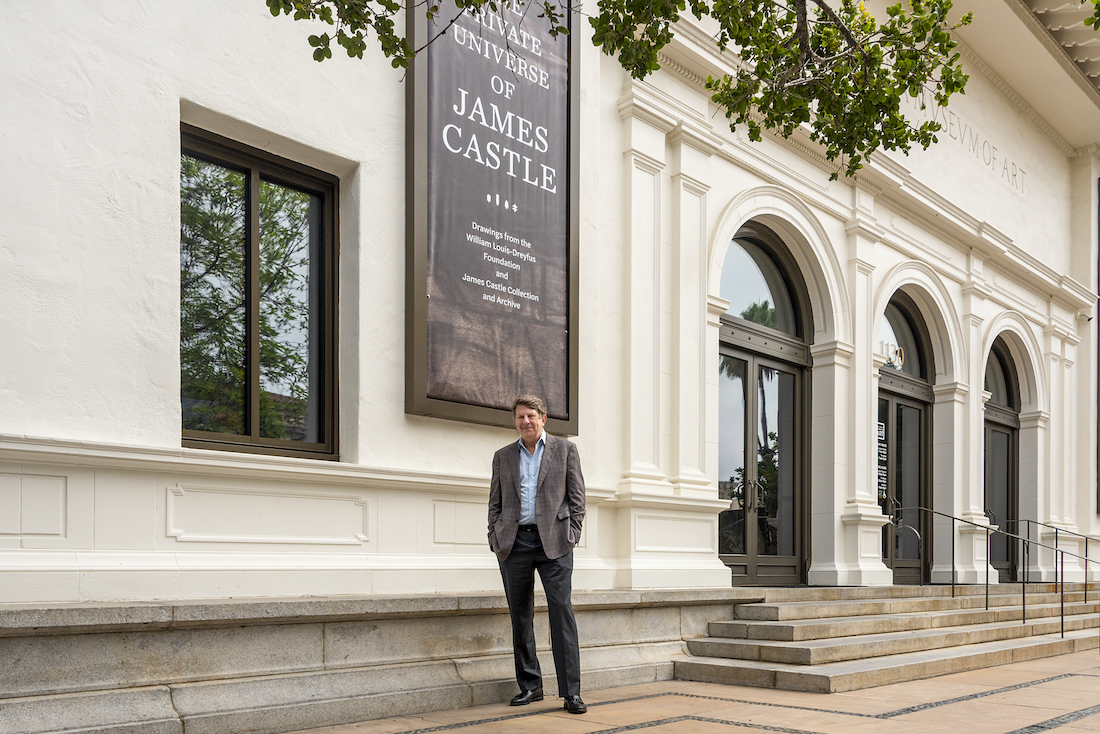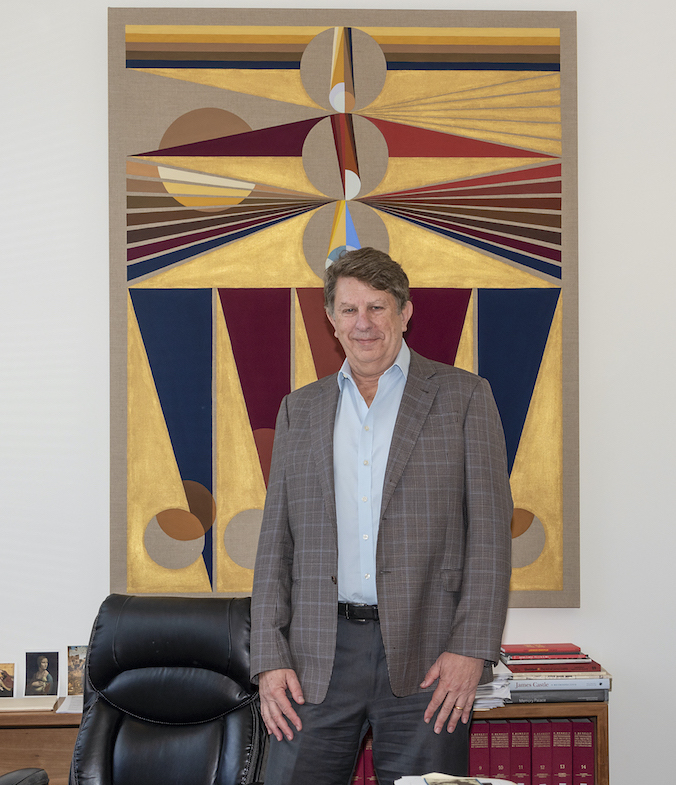In Conversation With SBMA’s Larry J. Feinberg

What is Art if not Pivotal? This week, I talked with the Robert and Mercedes Eichholz Director and Chief Executive Officer of the Santa Barbara Museum of Art (SBMA), Larry J. Feinberg PhD, at his office about the legacy of his brilliant leadership since being appointed in 2008.
Under his progressive vision, we find his art expertise x business wisdom noted in the SBMA’s internationally lauded exhibitions, programming, outreach, curators, staffing, and long-standing DEAI museum policies.
Clearly, his most visible accomplishment is to have spawned and led his team, trustees, donors, and the community to raise the unprecedented and targeted $50 million for the Imagine More capital campaign. The funding provided historic renovations to ensure the museum’s structural integrity, the safety of its permanent collection, and create dedicated galleries for contemporary art and photography.
The SBMA’s higher level exhibitions with publications include, Through Vincent’s Eyes: Van Gogh & His Sources (2022); Inge Morath (2021); Puja and Piety: Hindu, Jain, and Buddhist Art from the Indian Subcontinent (2016); The Paintings of Moholy-Nagy: The Shape of Things to Come (2015); Delacroix & the Matter of Finish (2013-14); The Artful Recluse: Painting, Poetry, & Politics in 17th-Century China (2013); Labour and Wait (2013); Pasadena to Santa Barbara: A Selected History of Art in Southern California, 1951-1969 (2012); Picasso & Braque: The Cubist Experiment (2011).
Like fellow art museum executive directors Glenn D. Lowry (MoMA NYC) and Timothy Potts (J. Paul Getty Museum Los Angeles), Feinberg holds a PhD in Art History from Harvard University. He also holds an MA in Art History from Harvard and an Executive MBA from the Kellogg School of Management, Northwestern University. Feinberg was the acting Chief of Staff in the Office of Children and Armed Conflict at the United Nations, under U.N. Under-Secretary General Olara Otunnu. He is currently a member of the Association of Art Museum Directors, the Human Rights Watch Santa Barbara Committee, The Medici Archive Project Council of Scholars Florence and NYC, and the Santa Barbara Downtown Organization.
Q. When you first arrived in 2008 and assessed the museum, what were your top priorities, and are they accomplished?

A. I thought the museum was a gem, and that it could be much more ambitious. It had been a regional museum, and I wanted it to operate on a national and international level.
An area I was most concerned about at first was doing much more ambitious, important, scholarly, and world-class exhibitions. I brought in Eik Kahng as Chief Curator in 2009 to help spark our momentum in this regard, along with the upgrading of our internal procedures and standards of art presentation.
This is a very sophisticated community; I thought they would appreciate high quality shows, and it turned out to be true. We want to have a whole range of voices in the art here. We also want to show the art of the great masters – Van Gogh, Picasso – which some might consider elitist, it is not. The greatest artists have the most to say and teach us about their cultures and ourselves. There are many people in Santa Barbara who will never get to NYC or Europe to view art, and the SBMA may be their only chance to view a Botticelli, Titian, Van Gogh, or Monet. Great art inspires people; I’d like to think that if a spot welder goes into a museum and views art by Rembrandt, he is inspired to do the best spot welds he’s ever done!
In addition to raising the bar on the exhibition program, I wanted to do more in education, which was always a part of the SBMA’s mission. Fortunately, I found on staff Patsy Hicks who took it on and greatly expanded our educational work in conjunction with the local schools. We may still be the only museum in the U.S. that has 100% participation of local schools and their students in museum activities. A large percentage of the students are Latinx. Pre-COVID we had 25,000 students participating in our programs in a town of 95,000 people. All students are given family passes. Several years ago, we made an adjustment in our admissions policy so that K-12 students, their teachers, and active Military personnel can visit for free anytime.
We wanted to be a leader in the country in what we are doing in exhibitions and education, and we are.
Your key accomplishments for the SBMA?
The most visible is the renovation of the SBMA. It’s wonderful that the staff, trustees, and the whole community came together as it was absolutely necessary. The museum had some structural, seismic, and other deficiencies that needed to be addressed, all of which are done.
Next were the elevation of the exhibitions and the education programs, which complement the exhibitions. Our education department outreach includes people with disabilities.
What we have done with diversity is an important part of the museum’s mission. Before DEAI and Social Justice issues became fashionable, we were at it early on. The first major show done after I arrived here 15 years ago was curated by Julie Joyce on the Anglo-Nigerian artist Yinka Shonibare [London] whose works address colonialism and race and filled the main floor of the museum. The second major show was the Warsaw ghetto photographs of Roman Vishniac and Jeff Gusky. We opened the show on Kristallnacht. From the museum, we led a march down State Street to the Jewish Federation. In the march, passersby asked what we were marching for and when they heard, joined in. By the time we arrived at the federation, we couldn’t all fit in the building!
Since then, our curators have never looked back, bringing works of many different voices, with a particular emphasis on exhibitions by artists who are Black, Indigenous, People of Color, female, minorities, and LGBTIQA. Our exhibition titled, The Architecture of Collage (2022-23), is African American Marshall Brown’s first solo museum exhibition and most comprehensive presentation of his collages to date. We acquired four works by the accomplished Ethiopian American artist Awol Erizku, and the Janna Ireland exhibition is upcoming. Kahng’s Van Gogh exhibition was the first international loan exhibition following the renovations. It was a community wide phenomenon with partner institutions – the Santa Barbara Symphony, Opera Santa Barbara, Ensemble Theatre Company, Santa Barbara Museum of Natural History, MOXI, Lotusland, Belmond El Encanto, La Cumbre Center for Creative Arts, 10 West Gallery, The Crafter’s Library, Sullivan Goss – An American Gallery, local restaurants, and hotels, thus bringing an art experience and economic stimulus to the entire locale.
We are also very proud of the great diversity of our staff in terms of ethnicity, LGBTIQA, and the fact that virtually every department head is a woman, and some are women of color.
Did you model the SBMA after another art museum?
When I came to Santa Barbara, I did have a specific model in mind: the Kimbell Art Museum in Fort Worth, Texas. The Kimbell always did very important shows with scholarly lectures and symposiums. I thought if people will go to Ft. Worth in the summer for a symposium when it is 110 degrees, they certainly will come to Santa Barbara to see what we are doing!
What new staff policies did you initiate?
The key policies I initiated are:
– Don’t be afraid to experiment and make mistakes. We go by the Jesuit motto, ask forgiveness not permission, and I add, stay within budget!
– We have a zero-tolerance policy for disrespectful behavior.
– For many years this museum did shows of important artists but did not acquire works by those artists. So, we made it a semi-official policy that if we do an exhibition of a significant artist, we should acquire at least one of their works, and we’ve done that for 15 years.
How does the museum since your tenure compare nationally and internationally?
I would describe us as a medium-size museum with a very good collection of 25,000 objects. We’ve taken pride in the fact that we punch above our weight. In light of our size, we can’t do a show of 200 works by Monet like the Met would do, but we scale it down and make sure that what we deliver is excellent and on the level of the Met. Certainly, we have a constituency that comes from Chicago, New York, and Washington and would not appreciate a museum that did not deliver at that level consistently. I’m proud of the fact that our exhibitions and their publications are done at a high scholarly level. They are recognized in the art world and have been featured in The New York Times, The Wall Street Journal, and Art News. Our reputation for scholarship, high quality exhibitions, and our curators who have high stature in the field, is the why and how other museums will lend great art to us for our exhibitions.
How did you decide to be the director of an art museum?
Actually, I wanted to be an artist, I’ve drawn pictures as far back as I can remember.
In high school I painted, drew, and cast sculptures in bronze. I started out as a studio artist. During summer break from college, I went to the St. Louis Art Museum exhibit of works by Leonardo da Vinci and Michelangelo. I thought these artists lived 500 years ago and I can’t touch this! Right there I decided to study these artists and make a career out of art by working in an art museum. When I retire, I plan to go back to my art!
What did you do to ensure that you would have a successful career path?
The best way I prepared myself was to get my PhD and MA in Art History, and to develop a broad knowledge of art history because art museums cover many different fields of art. The museums have excellent curators who compete for gallery space and funding. The museum director needs to be very knowledgeable to make those hard decisions about which shows to go with and which ones you don’t, and you want to be fair. I also hold an MBA degree, as the position requires you to direct business strategies, marketing strategies, and human resource policies. With an MBA, you will at least know the questions to ask, and be aware of what you don’t know.
My work as a chief curator provided me with the experience required for negotiating funding, working with a museum board, trustees, donors, and building relationships with my peers in the field, as well as creating valuable working relationships with museums.
I have experience as a lecturer, researcher, and author to provide insight into those areas of museum work. I also enjoyed working on boards for other organizations which rounds out one’s expertise.
Is there anything else you’d like to add?
These past 15 years seem to have gone by in a flash. I’ve enjoyed seeing the transformation of our museum. I do hope that the community takes pride in it, as I have, recognizing it for the jewel that it is, and that the SBMA continues to flourish.
411: www.sbma.net







You must be logged in to post a comment.